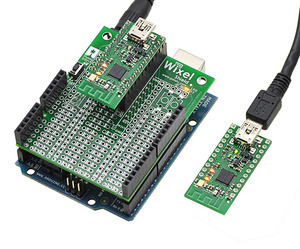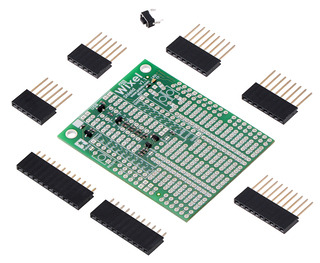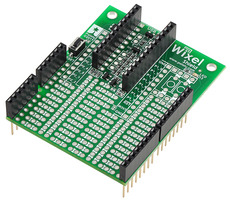The Wixel shield seamlessly enables a wireless link (with a typical range of ~50 feet) to duplicate the functionality of your Arduino’s USB interface, which means you can use the standard Arduino computer software to:
- wirelessly program the Arduino (this feature does not work on the Leonardo or the A-Star 32U4 Prime).
- wirelessly debug sketches with the Arduino serial monitor.
- wirelessly communicate with the Arduino from your computer’s virtual COM port.
More generally, the shield can also be used for wireless communication between an Arduino or Arduino clone and other embedded systems (including additional Arduinos). Alternatively, this board can also be used without an Arduino as a general-purpose Wixel prototyping board.
The Wixel shield does not interfere with the Arduino’s existing USB circuitry, so the Arduino’s traditional wired USB connection can still be used while the shield is connected.
Shield Features
- Wireless sketch uploading using the standard Arduino IDE
- General-purpose wireless serial communication between an Arduino and a computer or other electronics
- Prototyping space for easier/cleaner construction of custom circuits
- Shield-accessible Arduino reset button and pin 13 LED
- Four general-purpose 2/3 voltage dividers (can be used to safely connect 5V signals to 3.3V inputs)
- Two general-purpose MOSFETs (can be used as level-shifters or high-current outputs)
- Wixel socket allows the Wixel to be removed and used for other applications
Version 1.1 details
This is version 1.1 (v1.1) of the Wixel Shield, which replaces the original Wixel Shield for Arduino. It adds pass-throughs for the four new pins (SCL, SDA, IOREF, and an unused pin) introduced on the Arduino Uno R3 and present on all newer Arduinos. (The original Wixel Shield was designed before the R3 was released.) The v1.1 shield also features improved level shifter circuits that convert between the voltage on the Arduino’s IOREF pin and the Wixel’s 3.3 V, allowing it to work automatically with 3.3 V and 5 V Arduino boards. Generally speaking, most users should not notice any other differences between the two shield versions; details can be found in this section of the user’s guide.
Required Accessories
Wireless communication requires a pair of Wixels, which are sold separately or as part of a Wixel shield combination deal. An Arduino is not included.
 |
Included Hardware
The Wixel shield ships with all of the surface-mount parts populated. However, soldering is required for assembly of the included through-hole parts. The following through-hole parts are included with the Wixel shield:
- one extended/stackable 1×10 female header (for Arduino shields)
- two extended/stackable 1×8 female headers (for Arduino shields)
- two extended 1×6 female headers (for Arduino shields)
- one 1×12 female header (Wixel socket header)
- one 1×11 female header (Wixel socket header)
- one pushbutton (Arduino reset button)
This provides everything you need to plug an assembled Wixel into the shield and the shield into an Arduino.
|
|
Example Applications
The Wixel shield for Arduino opens the door for many new Arduino projects. Here are just a few project ideas:
- Program, debug/fine-tune, and control your Arduino-based robot without having to touch it.
- Stream data from a remote sensor (e.g. your outdoor weather station) to your computer or Arduino.
- Build a wireless remote control for your Arduino project.
- Maintain projects installed in hard-to-reach places or places where wires and cables would be impractical.
- Enable communication among a swarm of Arduino-based robots or a field of interactive elements (requires additional Wixel development).
- Use the Wixel as a secondary, parallel processor to add more computing power, I/O lines, and hardware peripherals to your Arduino (requires additional Wixel development).
Advanced users can write programs for their Wixels to make use of the its 12 free general-purpose I/O lines, including 5 analog inputs, or to develop more complex wireless communication networks.
The Wixel Shield’s wireless programming feature is not compatible with the Arduino Leonardo or the A-Star 32U4 Prime.



















